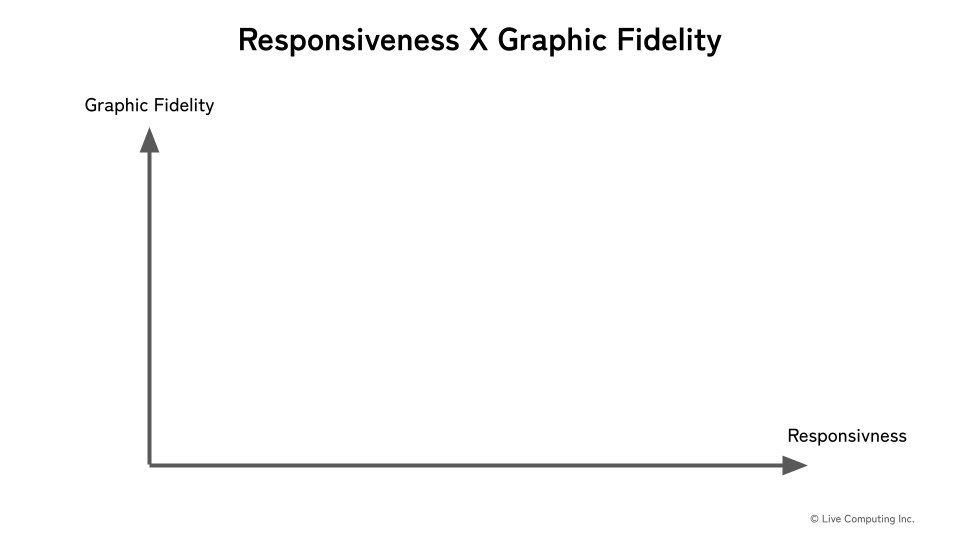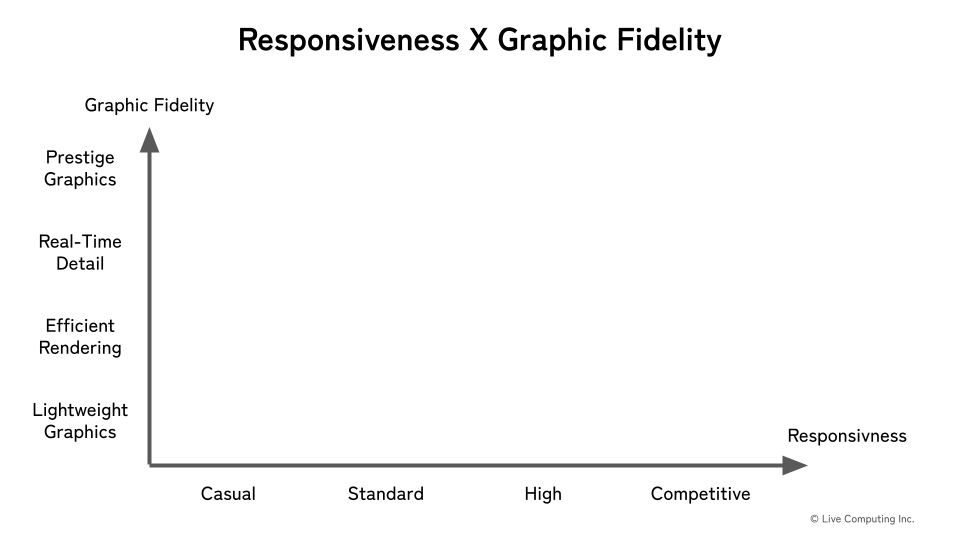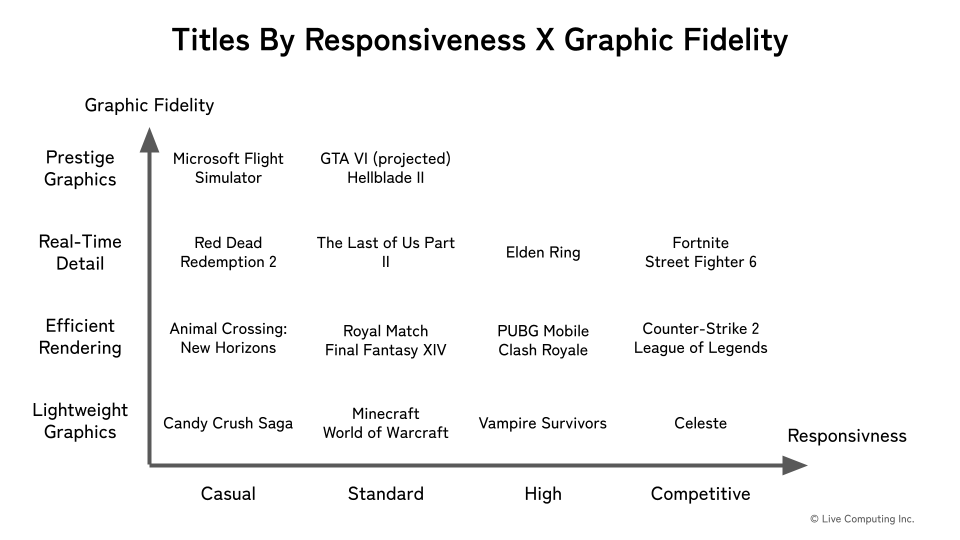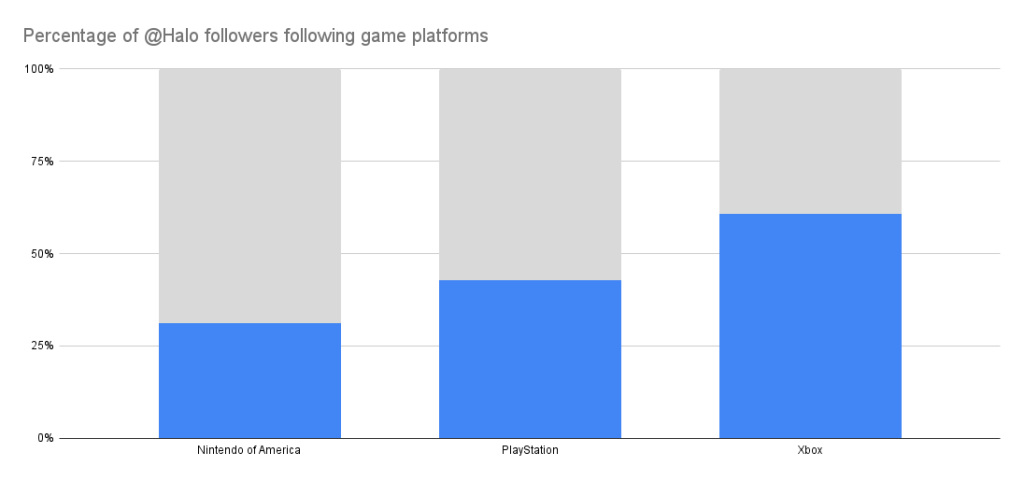When we talk about the technical requirements of a game, we are mainly referring to two aspects: how quickly it responds to player input (responsiveness) and how realistic or visually rich it looks (graphic fidelity). Some titles require quick responses without high-end visuals, while others prioritize visual fidelity and are designed for moderate responsiveness.
This article introduces a simple two-axis framework to position platforms, games, and user behaviors. But first, why do we need such a framework?

One reason is to gain insights into game platforms. What types of titles does each platform enable? Where is new hardware headed? Does Roblox support games requiring quick responses? How far will the Nintendo Switch 2 go in terms of both visual fidelity and responsiveness?
Another reason is to discuss and decide title development and marketing strategies. How much do players or target users value visual fidelity and responsiveness? Targeting the right audience reduces the risk of over-delivering, incurring unnecessary development costs, or miscommunicating expectations. How large are the segments closest to the title, and what do they suggest about expanding the audience or porting to other platforms? Is there a missed opportunity, a segment the title could reach with the right adjustments?
To explore these questions more systematically, the following framework divides games into four levels of graphic fidelity and four levels of responsiveness.
Graphic Fidelity
What is graphic fidelity? It is not about how impressive the graphics are. That depends on the player. Some like comic-style, while others prefer photo-realistic graphics. It is not about how easy the graphics are to develop. Simple design requires innovative concepts, sophisticated artwork, and multiple trial and error.
Graphic fidelity, in this framework, is about the level of technical resources required to deliver the game’s experience, such as rendering resolution, lighting and shading techniques, and asset complexity.
The following four segments describe different levels of graphic fidelity, based on the technical resources typically required to achieve them. Not every game needs to aim for the top tier. These tiers help clarify what level of visual ambition is appropriate for the experience the game is trying to offer. Hades shows high visual ambition through its hand-drawn art, animation, and effects, but it demands relatively low technical resources. Cyberpunk 2077, on the other hand, combines high visual ambition with significant technical demand.
A visually ambitious game doesn’t always require high graphic fidelity.
So let’s dive into each of the four segments.
Tier 1: Lightweight Graphics
Titles in this tier prioritize art direction over real-time rendering complexity. They often rely on minimal lighting, flat shading, and low-poly models. These games run smoothly on a wide range of hardware, remaining accessible without sacrificing visual impact.
Typical specs:
• 720p–1080p rendering
• Minimal post-processing
• Lightweight shaders or 2D pipelines
Examples:
Minecraft, World of Warcraft, Candy Crush Saga, Among Us
Success in this tier depends more on strong art direction and a cohesive visual identity than on technical complexity.
Tier 2: Efficient Graphics
This tier prioritizes broad hardware compatibility and visual clarity. Titles in this category make smart technical tradeoffs, offering clean and polished visuals while staying within modest performance budgets. Many are 3D, though some 2D games with dynamic lighting or rich animation also fit here. These games are optimized to scale across platforms, especially mobile, handheld, and entry-level PCs.
Typical specs:
• 1080p (often dynamic)
• Basic AO (ambient occlusion), soft shadows, baked lighting
• Medium-poly geometry, compressed textures
Examples:
Animal Crossing: New Horizons, INSIDE, Final Fantasy XIV, PUBG Mobile
The challenge in this tier is finding the right balance, delivering visual appeal without exceeding the performance budgets of lower-spec hardware.
Tier 3: Real-Time Detail
Titles in this tier target gamers who seek rich graphic experiences, whether photo-realistic or stylized. What sets them apart is the complexity of their lighting models, large-scale environments, and high-fidelity animation pipelines, often requiring larger memory budgets and stronger hardware. These titles typically target high-end consoles or PCs, as their rendering demands exceed the capabilities of entry-level systems.
Typical specs:
• 1080p–1440p (native or dynamic)
• Real-time lighting, dynamic shadows
• Higher-poly assets, large texture budgets
Examples:
Fortnite, Genshin Impact, The Last of Us Part II
These games require greater technical effort, not merely to achieve realism, but to support responsive, complex game worlds.
Tier 4: Prestige Graphics
While most titles here pursue realistic styles, that’s not the key criterion. These games typically target high-end PCs or the latest consoles, and often include cinematic framing, facial animation systems, and GPU-intensive effects like ray tracing, global illumination, and volumetrics.
Typical specs:
• 1440p–4K rendering (native or advanced upscaling)
• Real-time global illumination, ray tracing, volumetrics
• High-end assets, photogrammetry, facial capture
• Often runs at sub-60fps in quality mode (30–40fps is generally accepted by players)
Examples:
Microsoft Flight Simulator, Hellblade II, Grand Theft Auto VI (expected)
This tier sits at the frontier of what current hardware and engines can deliver in real time, often serving as a benchmark for the current hardware generation.

Responsiveness
Graphic fidelity tells us how a game looks. Responsiveness tells us how it feels to control.
This axis measures how much timing precision and input sensitivity a game demands, from relaxing life sims to twitch-fast fighting games. We define four tiers of responsiveness, from passive input loops to esports-level precision.
Tier 1: Casual Responsiveness
These games create low-pressure input environments. Players can tap or click freely, without strict timing. These games run on most platforms as they don’t require much processing power. Timing isn’t critical, and input mistakes have little consequence.
Typical specs:
• 30fps is acceptable
• 100ms+ input latency tolerated
• No buffering or animation canceling
Examples:
Candy Crush Saga, Animal Crossing: New Horizons, Microsoft Flight Simulator
Tier 2: Standard Responsiveness
Titles in this tier feel responsive, but the game doesn’t punish minor timing errors. Input windows are generous, and player inputs typically trigger animations that run their course, such as attack or dodge sequences.
Typical specs:
• 30–60fps
• 60–100ms input latency
• Animation locks, light input buffering
Examples:
Minecraft, Final Fantasy XVI, The Last of Us Part II
Tier 3: High Responsiveness
This tier covers games where precise control is essential. Players benefit from fast reactions and suffer from mistimed inputs. Low latency is crucial, and mechanics like input buffering and animation canceling are often built into the experience.
Typical specs:
• 60fps stable
• <50ms input latency
• Tight input windows, rollback netcode preferred for online
Examples:
PUBG Mobile, The Legend of Zelda: Breath of the Wild, Elden Ring
Tier 4: Competitive Responsiveness
Tier 4 titles demand frame-perfect execution. Players compete in matches where a single frame of lag can mean defeat. There’s little margin for error. Precision is the game.
Typical specs:
• 60–120fps (or higher)
• <30ms input latency (target)
• One-frame input windows (1/60th of a second), rollback netcode standard
Examples:
Street Fighter 6, Fortnite, Valorant
Mapping Titles on the Responsiveness × Fidelity Grid
How do modern titles fit into this framework? We’ve mapped several to illustrate the range and trade-offs between responsiveness and fidelity.

Microsoft Flight Simulator sits in the upper-left corner, which has the highest level of visual fidelity, paired with minimal responsiveness demands. It pushes graphical boundaries with real-time weather, satellite data, and volumetric clouds, but players aren’t reacting frame-by-frame.
Celeste stands at the bottom-right. Its visuals are minimalist and retro-inspired, firmly in the low-fidelity tier. But beneath that simple surface lies some of the tightest control in modern gaming. Precision jumps, frame-perfect dashes, and instant restarts make it a showcase for responsiveness.
Counter-Strike 2 sits above Celeste but below Fortnite and Street Fighter 6. It’s built for absolute responsiveness: quick peeks, headshots, and pixel-level precision decide every round. Its graphics remain intentionally restrained, as realism takes a back seat to clarity, performance, and map legibility.
Fortnite sits high on the responsiveness axis, while still pushing toward high fidelity. With twitchy gunplay, fast building, and updates that rarely break performance, it balances speed, style, and cross-platform reach.
The diagram shows how these titles are positioned within our framework. These positions are open to debate. And that’s where real insights emerge.
Framework evolves with generations
As technology advances, what qualifies as Tier 4 today may settle into Tier 3 tomorrow. But the relative positioning remains useful, and that is what makes this framework valuable for long-term planning. This framework is not static, and isn’t tied to fixed specs.
We’ll continue updating this over time, and try not to add a fifth tier that makes it needlessly complex.
What’s Next
In upcoming posts, we’ll explore how this framework applies to platform strategies, title development and marketing, and user behavior. Comments and questions are always welcome. Thanks for reading.

